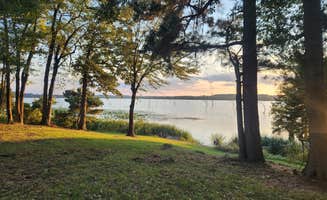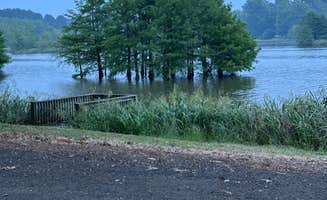Dispersed camping near Washington, Arkansas offers primitive sites with minimal infrastructure across several undeveloped areas. Most locations feature direct water access to Bois D'Arc Lake, with camping elevations averaging 350 feet above sea level. The region experiences humid subtropical climate conditions with summer temperatures regularly exceeding 90°F and winter lows occasionally dropping below freezing.
What to do
Fishing opportunities: Bois D'Arc Lake provides multiple access points for anglers seeking bass and catfish. A recent visitor to Bois D'Arce Lake Peninsula noted it offers "great clean stop" with waterfront access even during midweek visits when the area sees minimal traffic.
Wildlife observation: The natural lakeside setting supports diverse bird populations, particularly during spring and fall migrations. Early morning hours provide optimal viewing conditions before daytime temperatures rise.
Photography: Sunrise and sunset conditions create distinctive lighting across the lake surface. The combination of water, forest edges, and minimal light pollution makes these primitive camping areas suitable for astrophotography during clear nights.
What campers like
Privacy between sites: The dispersed nature of camping at Bois D'Arc Lake Wildlife Area means campers rarely encounter crowds. Weekday camping particularly ensures minimal disruption with one camper reporting they "spent night here mid week..only a couple of vehicles came through."
Cost-free camping: Budget-conscious campers appreciate that permits and fees are not required at most dispersed sites. One visitor emphasized the value proposition simply: "Easy to get to and great spots on the late! free!"
Water proximity: Multiple camping spots allow setting up tents within short walking distance of the shoreline. This proximity allows for convenient fishing, swimming access, and morning views across the water.
What you should know
Limited cellular coverage: Service ranges from spotty to nonexistent at most sites around Spillway Landing by Cedar Bayou. Download maps and important information before arrival.
Weather considerations: Trail conditions vary significantly based on recent precipitation. One camper noted the access routes would "be better after a rain" while still rating them accessible as "Level 1 for sure."
Mosquito preparation: Insect activity increases dramatically during warmer months, particularly in areas closer to water. Bring appropriate repellents, netting, and protective clothing.
Local wildlife: Free-ranging dogs have been reported in some camping areas. Drive cautiously through residential sections approaching camping areas as noted by a visitor who observed "2 Dogs running around. So please go speed limit through res'."
Tips for camping with families
Arrival timing: Plan to arrive with several daylight hours remaining to locate suitable camping spots. Sites are unmarked and require time to evaluate for safety and comfort.
Water safety: Poison Springs Nevada Road 424 and other lakeside camping locations lack designated swimming areas or lifeguards. Maintain constant supervision of children near water.
Supply planning: No potable water sources exist at rustic camping sites near Washington, Arkansas. Families should calculate 1-2 gallons per person per day plus additional water for cleaning and cooking needs.
Entertainment options: Pack analog entertainment options as limited connectivity means digital devices may not function reliably for keeping children engaged during downtime at camp.
Tips from RVers
Access evaluation: Drive-in dispersed camping near Washington requires careful assessment of road conditions before committing to routes with larger vehicles or trailers. Most access roads lack turnaround areas if conditions deteriorate.
Leveling requirements: Prepare adequate leveling equipment as primitive sites lack designated parking pads or level surfaces. Natural terrain features often determine available parking positions.
Resource management: With no dump stations or water hookups available, self-contained camping requires careful water usage and waste storage planning. Calculate tank capacities based on your expected stay duration plus a 1-2 day buffer.



